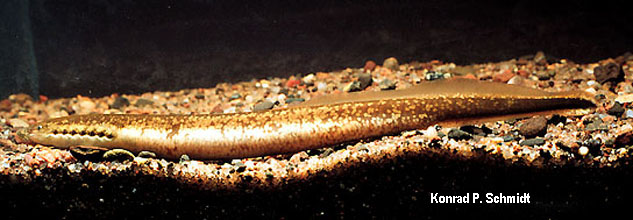| Petromyzontidae (Northern lampreys), subfamily: Petromyzontinae |
| 17 cm TL (male/unsexed); max. reported age: 6 years |
|
demersal; freshwater |
| North America: St. Lawrence River, Quebec, west through Great Lakes and northern Mississippi River basin to Red River (Hudson Bay basin), south Manitoba; localized in Ohio River basin of northwest Pennsylvania, west Virginia, east Kentucky, north and south central Ohio and north Indiana; Missouri River basin. |
|
Adults: 8.6-16.6 cm TL. Body proportions, as percentage of TL (based on 59 specimens measuring 9.8-15.8 cm TL): prebranchial length, 7.4-9.9; branchial length, 8.7-11.9; trunk length, 46.7-54.6; tail length, 27.7-33.7; eye length, 1.0-2.0; disc length, 3.6-6.4. The urogenital papilla length, as a percentage of branchial length, in 25 spawning males measuring 9.9-14.95 cm TL, 6.7-21.7. Trunk myomeres, 47-58. Dentition: supraoral lamina, 1-4 unicuspid teeth, usually 2; infraoral lamina, 6-11 teeth, usually unicuspid but one may be bicuspid; 4 endolateral teeth on each side; 0-1, strong mode of 0, bicuspid endolaterals in total, the other endolaterals unicuspid; 1-3 rows of anterials; first row of anterials, 3 unicuspid teeth; 1-5 rows of exolaterals on each side, usually 3-4; 2-3 rows of posterials; first row of posterials, 10-11 unicuspid teeth; crest of transverse lingual lamina strongly w-shaped and with either indistinct or about 20 small cusps, the median one not enlarged; longitudinal lingual laminae with 17 cusps each. Marginal membrane vestigial. A small gular pouch is present in both males and females. Velar tentacles, 1-2, smooth. Body coloration (preserved) in adults darker (grayish brown) on the dorsal and upper lateral aspects and lighter (pale gray or silvery white) on the lower lateral and ventral aspects, giving a distinctly bicolored appearance. Lateral line neuromasts unpigmented. Extent of caudal fin pigmentation, 25% to more than 75%. Caudal fin shape, rounded. |
| Freshwater. Generally associated with warmwater habitats and tolerant of variation in terms of discharge, water temperature, and substrate. Mainly inhabits warmwater, isolated segments of moderate-sized to large streams with summer flows 0.03-31 m3/s, summer water temperatures 14-25.6 ˚C (Ref.89241). Adults inhabit clean, clear gravel riffles and runs of small rivers. Ammocoetes occur in quiet water over sand, silt and debris (Ref.1998). Metamorphosis occurs in late August to September, in Michigan and extends to early October in Québec (Ref. 89241). Non-parasitic, the adults and possibly the larger ammocoetes in the resting stage do not feed (Ref. 1998). Adults live less than 6 months. In Michigan, the spawning period is from 13 May to 6 July, at water temperatures between 12.8-23.3 ˚C, with peak spawning activity in late May to mid-June. In Québec, spawning occurs in May, at water temperatures between 12.8-17.2 °C, peaking at temperatures between 13.3-15.6 °C. Nests are usually in the open and are poorly defined, but have also been found downstream of large stones 18-36 cm in diameter, or on a patch of gravel downstream of a submerged log. The nests are found in streams having 3.5-8 m width, 10-61 cm depth, and 0.1-0.6 m3/s flow. Up to 13 spawning lampreys have been found in a nest. There are reported occurrences in Michigan of communal spawning of Northern Brook Lamprey with Silver Lamprey (Pine River), and of Northern Brook Lamprey with Sea Lamprey (Devils River). Fecundity, 1,200 eggs/female. During spawning, adults preyed upon by Ambloplites rupestris. In the Laurentian Great Lakes Basin, it has been negatively affected by control measures directed towards Petromyzon marinus, except for the chemosterilization of males, which affects only the latter species. Vladykov (1949) reported that in the province of Québec, Canada, fishermen use ammocoetes as bait for sportfishes (Ref. 89241). |
|
Least Concern (LC); Date assessed: 17 February 2012 Ref. (130435)
|
| harmless |
Source and more info: www.fishbase.org. For personal, classroom, and other internal use only. Not for publication.

